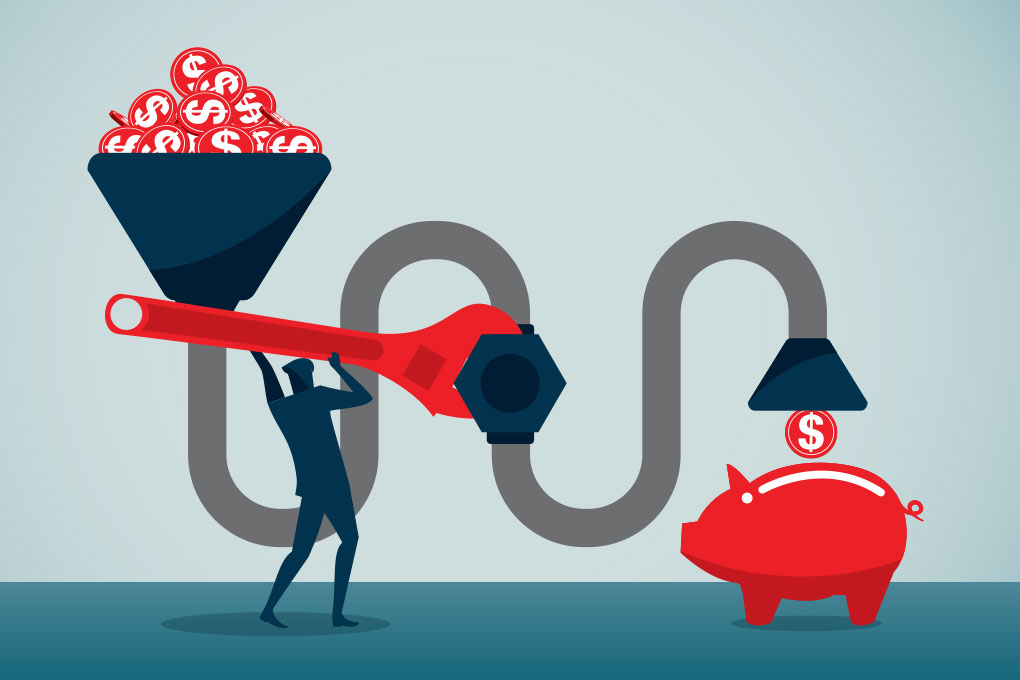The Grid
We can explore this topic using a simplified fictional example.
Let's start with a PM employed by a financial institution. He earns a 1% fee on $100M AUM, making his total gross revenue for the year $1M.
Like most employee PMs, his take-home income is based on a compensation grid set by his firm. Everyone's contract is different; for this example, we will assume 50%, or $500,000.*
As a T4 employee, he will pay income tax on that amount. The combined provincial and federal tax rate varies by province. For 2023, the top marginal tax rates in Canada’s most populous provinces of Ontario, Quebec, Alberta, and British Columbia are 53.5%, 53.31%, 48% and 53.5% respectively.¹
If we assume a combined effective tax rate of 50% for our example, the advisor will ultimately keep $250,000 of the total $1M in management fees he has generated. As noted above, his firm will retain half of every dollar brought into the business. Provincial and federal tax authorities will then keep 25¢ of the remaining 50¢ of each dollar.
The advisor's firm provides services for the 50% it retains. Some of these services include a regulatory platform, technology, compliance oversight and other infrastructure needed to operate in a regulated environment.
Business Owner
When you start your own firm, the structure is completely different. You are truly running your own business. You have the flexibility to determine how to set the fee structure, how to manage the firm's revenue, how to pay yourself, and more.
Taking the same fictional scenario as above, let's look at a PM who owns her own firm. She has the same sized book of $100M AUM, and the same fee of 1%. But in this case, the total revenue of $1M goes into her corporation.
From the total revenue generated and accumulated in her corporation, she will use funds to cover the costs of running her business. This year, she spent approximately 30% of her total earnings, or $300,000, on overhead costs such as technology, marketing, compliance support, etc. From the remaining $700,000 she can pay herself a salary, draw dividends, reinvest in the company, etc.
Expert Insights
One of the benefits of entrepreneurship is the opportunity to take home more of your earnings. Two important reasons for this are 1) control of operational costs, and 2) flexibility in how you structure your personal income.
Vipool Desai, President, Ara Compliance Support, has worked with many early-stage independent firms as they are being created. In a video interview with Devin Cabel, Regional Vice President, NBIN, he notes that PMs who launch their own firms often see a difference in income. "In many cases, if you compare what you are paying your dealer versus the cost of actually running your own business, you'll find the cost of running your own business is lower — and in many cases, significantly lower."
Owning your PM business allows for additional possibilities when structuring your personal income and tax planning. For example, a business owner can pay themselves a salary while also withdrawing a dividend payment depending on what works for them and for the business.
"It's very hard to accumulate wealth in that kind of environment [as a T4 or T4A employee]," says Vipool. "It's very hard to pass on wealth to future generations, to do tax planning, income splitting, estate planning...so, you need to have a business — an active business — to have those benefits."
If you are curious to gauge what your potential earnings could be as an independent, check out NBIN's income calculator.
Looking to the future, you’ll have the opportunity to capitalize on the equity you have worked hard to build when you sell your business. (Keep an eye out for more information about succession in a future article.)
Which Option Is Right for You?
Comparing employee and owner income models is like comparing apples to oranges. In one, your income is determined by your firm; in the other, you decide how to be paid — and more.
The main thing is to know that you have options. If you're a financial professional, or if you are younger and just going into this industry, it's important to know your options so you can make the choice that's right for you.
NBIN has helped hundreds of PMs explore the possibility of launching their own firms. To learn more, visit Going Independent.
* In some cases, the percentage may be reduced by details in the compensation plan. For example, if certain goals are not achieved, points are removed.
† This article is not intended to provide tax, legal or accounting advice. Consult with a qualified professional to determine the best approach, including with respect to the guidelines provided by the Canada Revenue Agency.

